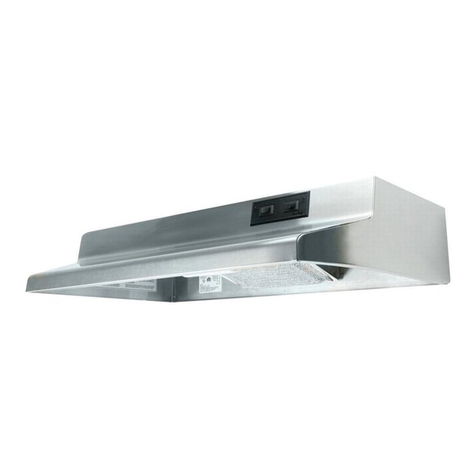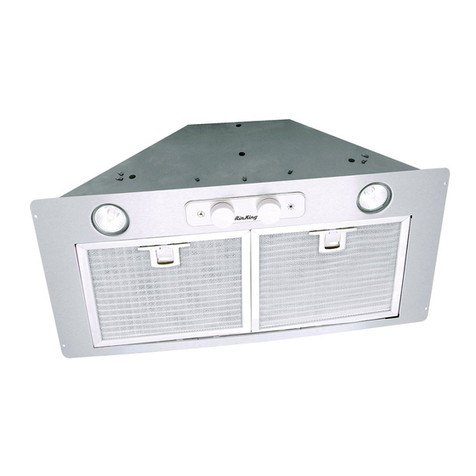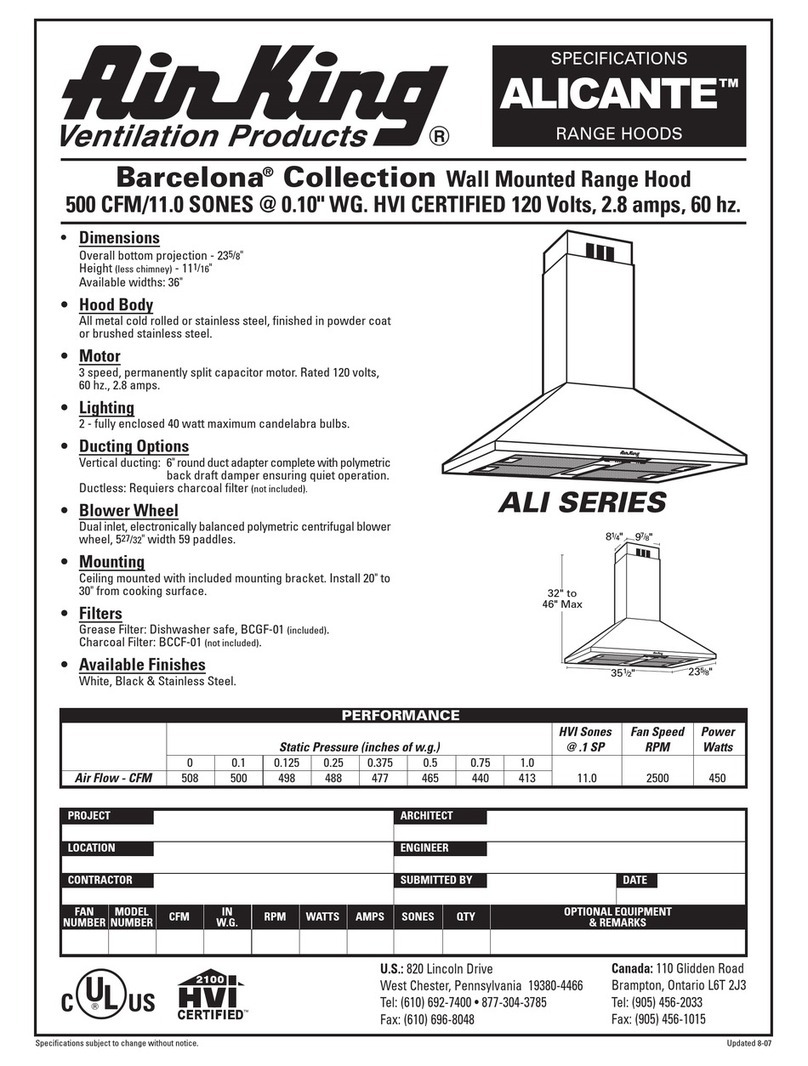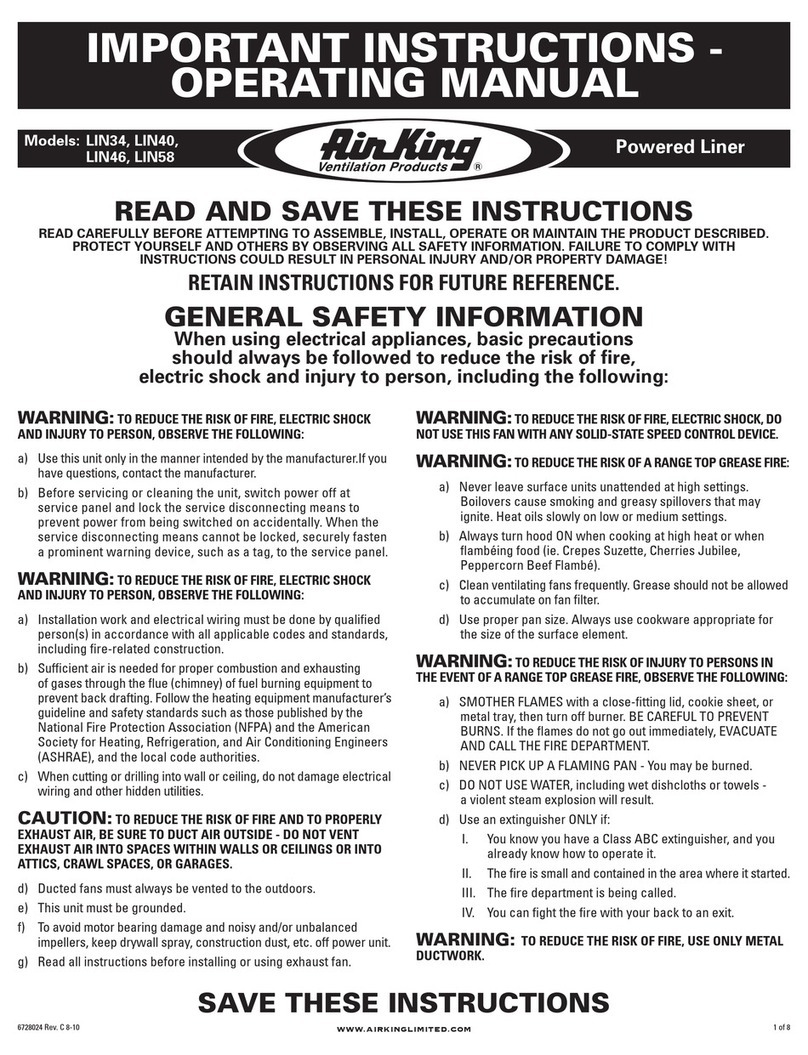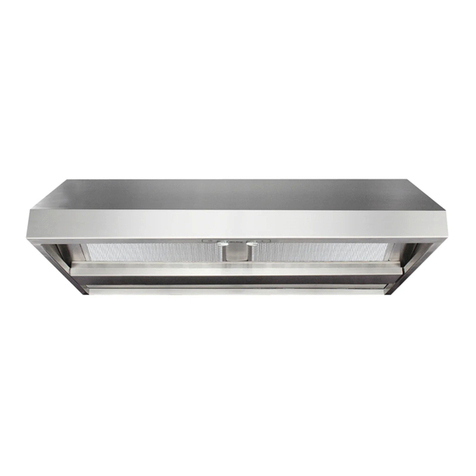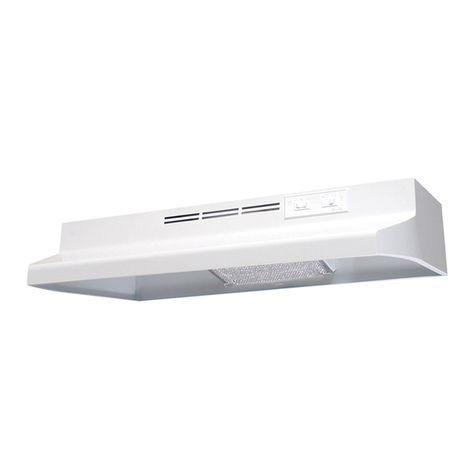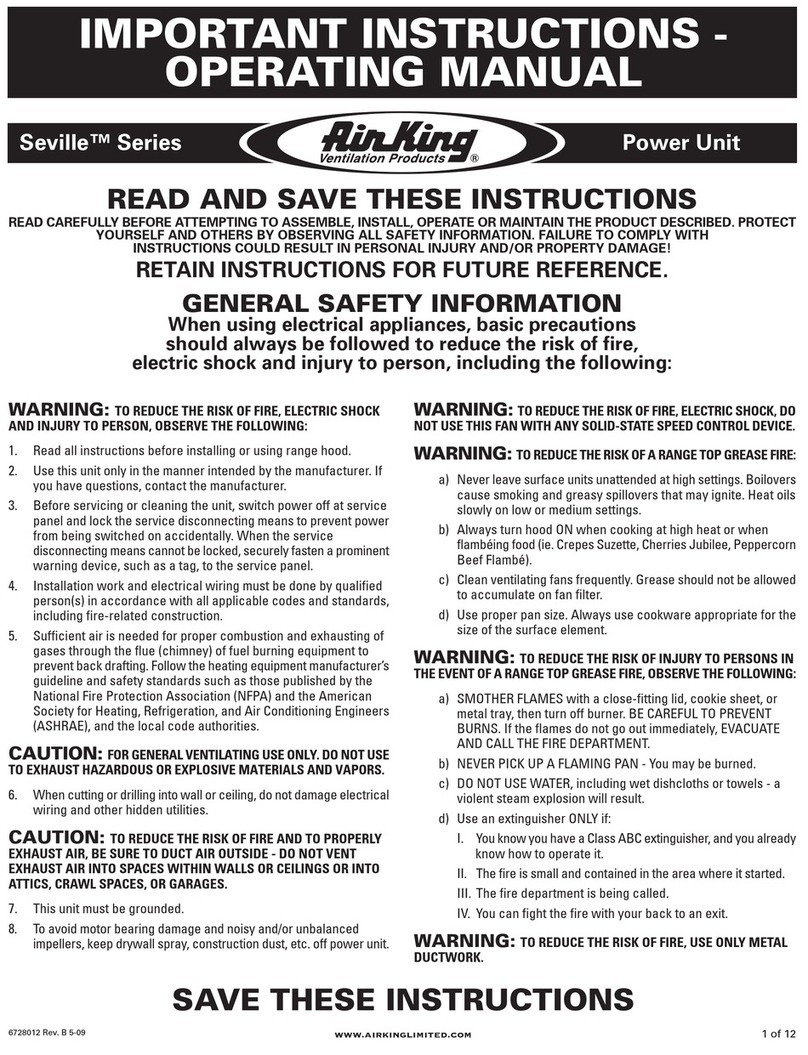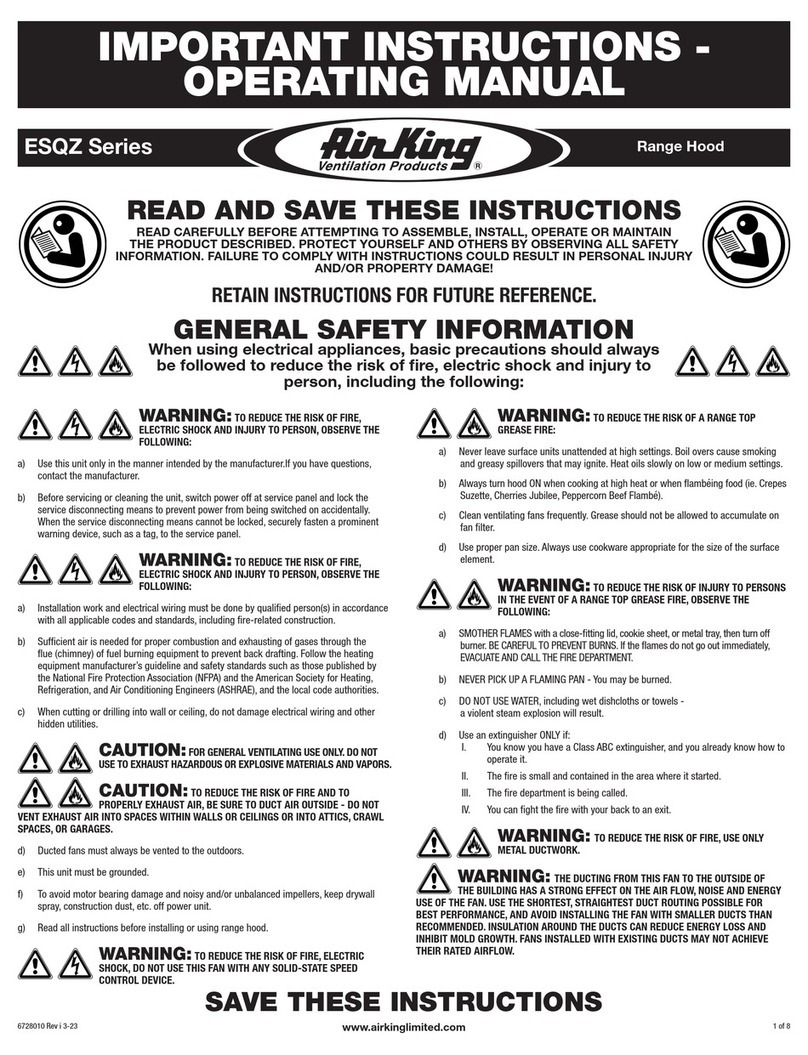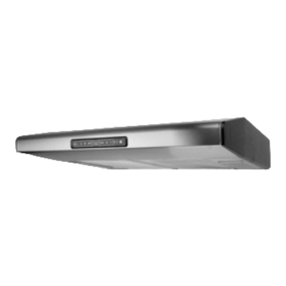Read and save these instructions.
Important Safeguards
WARNING • DISCONNECT THE RANGE HOOD FROM
POWER SUPPLY BEFORE SERVICING.
WARNING • TO REDUCE THE RISK OF FIRE OR
ELECTRIC SHOCK OR INJURYTO PERSONS OBSERVE
THE FOLLOWING:
a) Use th s un t only n the manner ntended by the
manufacturer. If you have quest ons, contact the manufacturer.
b) Before serv c ng or clean ng the un t, sw tch power to off at
serv ce panel and lock the serv ce d sconnect ng means to
prevent power from be ng sw tched on acc dentally. When the
serv ce d sconnect ng means cannot be locked, securely fasten a
prom nent warn ng dev ce, such as a tag, to the serv ce panel.
c) Installat on work and electr cal w r ng must be done by
qual f ed person(s) n accordance w th all appl cable codes and
standards, nclud ng f re-rated construct on.
d) Suff c ent a r s needed for proper combust on and exhaust ng of
gases through the flue (ch mney) of fuel burn ng equ pment to
prevent back draft ng. Follow the heat ng equ pment
manufacturer’s gu del ne and safety standards, such as those
publ shed by the Nat onal F re Protect on Assoc at on (NFPA) and
the Amer can Soc ety for Heat ng, Refr gerat on and A r
Cond t on ng Eng neers (ASHRAE), and the local code author t es.
e) When cutt ng or dr ll ng nto wall or ce l ng, do not damage
electr cal w r ng or other h dden ut l t es.
f) Ducted fans must always be vented to the outdoors.
CAUTION • For general vent lat ng use only. Do not use to
exhaust hazardous or explos ve mater als and vapours.
CAUTION • To reduce the r sk of f re, use only metal ductwork.
CAUTION • To reduce the r sk of f re and to properly exhaust
a r, be sure to duct a r outs de. Do not vent exhaust a r nto spaces
w th n walls or ce l ngs, or nto att cs, crawlspaces, or garages.
WARNING • TO REDUCE THE RISK OF A RANGE TOP
GREASE FIRE:
a) Never leave surface un ts unattended at h gh sett ngs.
Bo lovers cause smok ng and greasy sp llovers that may gn te.
Heat o ls slowly on low or med um sett ngs.
b) Always turn the hood ON when cook ng at h gh heat or when
cook ng flam ng foods.
c) Clean vent lat ng fans frequently. Grease should not be
allowed to accumulate on fan or f lter.
d) Always use proper pan s ze. Always use cookware
appropr ate for the s ze of the surface element.
WARNING • TO REDUCE THE RISK OF INJURY TO
PERSONS IN THE EVENT OF A RANGE TOP GREASE
FIRE, OBSERVE THE FOLLOWING:
a) Smother flames w th a close-f tt ng l d, cook e sheet, or metal
tray, then turn off the burner. BE CAREFUL TO PREVENT
BURNS. If the flames do not go out mmed ately, EVACUATE
AND CALL THE FIRE DEPARTMENT.
b) NEVER p ck up a flam ng pan – you may be burned.
c) DO NOT use water, nclud ng wet d shclothes or towels – a
v olent steam explos on w ll result.
d) Use an ext ngu sher ONLY f:
1. You know you have a class ABC ext ngu sher, and you
already know how to operate t.
2. The f re s small and conta ned n the area where t started.
3. The f re department s be ng called.
4. You can f ght the f re w th your back to an ex t.
Su table for use w th sol d-state speed control.
Installation Preparation
To nstall th s hood you w ll requ re two people. You w ll need
the follow ng tools and mater al to complete th s nstallat on:
• dr ll
• flat head screwdr ver
• Ph ll ps head screwdr ver or cordless dr ll and Ph ll ps head b t
• t n sn ps
• 3/8” nut dr ver or ratchet w th extens on
• measur ng tape
• hand saw or j g saw
• electr cal tape
• duct tape
• standard electr cal connector
Ensure the power has been turned off before beginning this
insta ation.
1. Remove the range hood from the carton.
2. Lay the hood ups de down on a table covered w th cardboard
or paper to prevent scratch ng of the table or hood.
3. Remove the 2 grease f lters from the hood (f g. 1). Place them
somewhere safe so they w ll not get damaged.
4. Remove the range hood’s bottom cover – 4 screws hold t n
place (f g. 1). Place the cover somewhere safe so t does not get
damaged and save the screws.
Figure 1
5. Remove the range hood’s lamp cover by squeez ng n the s des
– t s held n place by tens on aga nst 2 tabs on the range hood.
Place t somewhere safe so t does not get damaged.
6. Remove the range hood’s damper frame and nstallat on
screws from ns de the range hood and keep them somewhere
safe unt l needed.
7. Remove the range hood’s w re compartment cover. It s held n
place by 1 screw. Place the w re cover and screw somewhere safe
unt l needed.
8. Remove the range hood’s blower. Use a 3/8” nut dr ver or
ratchet to remove the 4 nuts hold ng t n pos t on (f g. 1). Place
the blower and nuts somewhere safe unt l needed.
9. Turn the hood r ght s de up so you can see the duct knockouts
and mount ng holes.
Cabinet Preparation for
Hood Support
We recommend that after nstallat on the bottom of the hood
should be no less than 20” and no more than 30” above the
stove’s heat ng elements or burners.
1. If the bottom of the cupboard s recessed above the bottom of
the cupboard door, then t w ll be necessary to attach wood str ps
to the bottom of the cupboard n the locat on where the range
hood w ll mount.
2. By us ng a template or by measurement, transfer the proper
locat on to nstall the wood str ps on the bottom of the cab net.
The wood str ps should l ne up w th the 4 keyhole slots on the
top of the range hood.
Ducting and Electrical
Knockout Preparation
DQ Ser es range hoods are fully convert ble
for vert cal, hor zontal or ductless operat on
(F g. 2). Your range hood s suppl ed w th a
31/4” x 10” damper frame for a trans t on
p ece from the hood to the duct ng. Below s
a br ef duct ng nstallat on descr pt on. Your
nstallat on w ll depend on whether there s
ex st ng duct ng or the ease of nstall ng a
duct ng run.
Vertical
Vert cal s the most common. If your k tchen has an att c space
above, the duct ng may be run up through the cupboard and att c
to a roof cap. If your k tchen has a soff t above the cupboards,
you may run the duct up nto the soff t and then d scharge
hor zontally through the outs de wall to a wall cap.
Horizontal
If the range hood s located aga nst an outs de wall, hor zontal
d scharge s preferred prov ded there are no obstruct ons, such as
wall jo sts or a place where open ngs are d ff cult to make.
Ductless
In a ductless nstallat on the a r s re-c rculated back nto the
k tchen. Th s method s energy eff c ent because you are not
exhaust ng cond t oned a r, however the a r del very w ll be
somewhat less. If you do not ant c pate heavy cook ng th s
method may be preferred. It w ll not be necessary to remove any
duct knockouts, however you w ll have to remove the range
hood’s vent nsert (f g. 3). You should use the 2 Charcoal/Grease
f lters (part CF-01 for 30” – not suppl ed) to help remove
cook ng odours. The charcoal/grease f lters may be purchased
through your reta ler, wholesaler, or d rectly through A r K ng.
These f lters are not d shwasher safe and must be replaced at
regular ntervals, depend ng on use.
Figure 3
Electrical Knockout
The preferred locat on for the electr cal connector, vert cal or
hor zontal, w ll depend on ex st ng nstallat on or ease of rout ng
w r ng. All electr cal connect ons must comply w th nat onal and
local codes. Transfer the locat on of the selected range hood
knockouts to the bottom of the cupboard or onto the wall, then cut
or dr ll a hole to allow for clearance of the electr cal cable clamp.
Be careful not to cut nto any h dden ut l t es, such as electr cal
w res.
Once you have planned your duct ng and electr cal nstallat on,
you can prepare the hood by remov ng the appropr ate knockouts
and attach ng the damper frame and an approved electr cal
connector (not suppl ed).
Removing Duct Electrical Knockouts
and Damper Frame Installation
1. To remove the selected duct knockout, pry up the edge of the
knockout area and sn p or break the attachment po nts (f g. 4).
Figure 4
2. Once the des red knockout s removed, attach the damper
frame and secure nto pos t on us ng the two 3/8” screws suppl ed.
You may use duct tape to create an a r t ght seal between the
damper frame and the hood (f g. 5).
Figure 5

